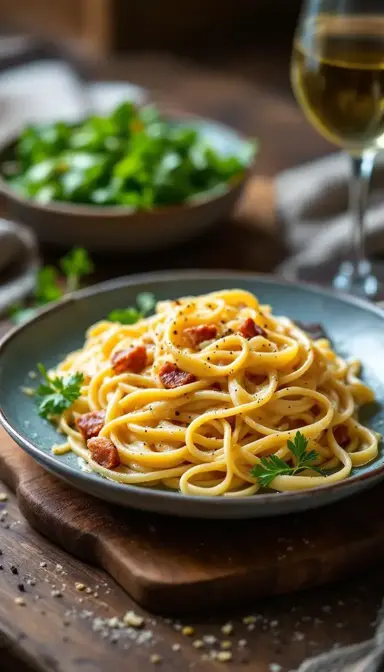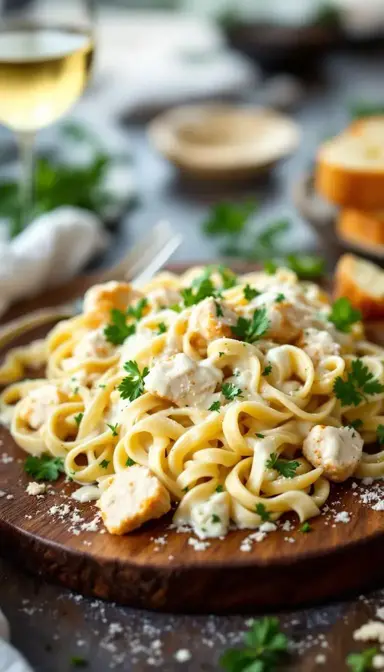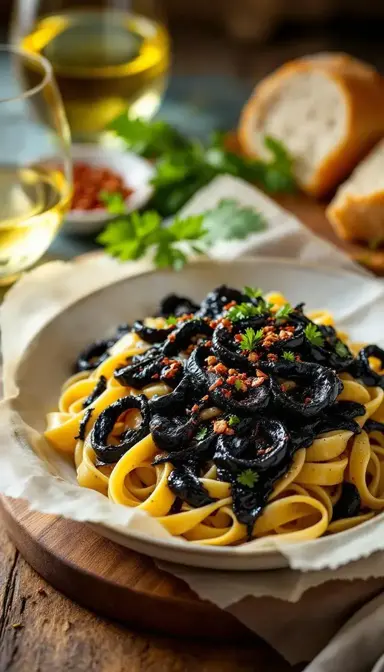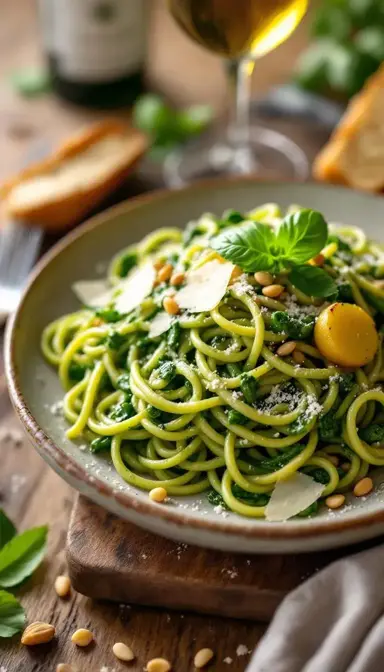There’s something almost sacred about a well-made carbonara. It’s not just pasta—it’s alchemy. The way golden egg yolks and salty Pecorino weave themselves into a silken cloak around each strand of fettuccine, the crackle of black pepper hitting your tongue before the richness of guanciale follows—this is food that demands attention. I still remember my first real carbonara, eaten at a tiny trattoria near the Pantheon, where the waiter scoffed when I asked for cream. “No, no,” he said, wagging a finger. “Just eggs, cheese, and courage.”
Here’s how to make it right.
Essential Ingredients & Tools
Ingredients
- 150g guanciale (or pancetta if unavailable), cut into ¼-inch lardons
- 3 whole eggs + 2 yolks, room temperature
- 50g Pecorino Romano, freshly grated
- 25g Parmigiano-Reggiano, freshly grated
- 1 tsp freshly cracked black pepper
- 400g fettuccine (or spaghetti for a classic touch)
- Salt for pasta water (about 2 tbsp per liter)
Tools You’ll Need
- Large pot for boiling pasta
- Heavy skillet (cast iron or stainless steel)
- Tongs or pasta fork
- Mixing bowl
- Grater (microplane works best for cheese)
Serves 4 | Ready in 30 minutes
How to Make Fettuccine alla Carbonara
- Mise en Place (Or, How to Avoid Panic)
Carbonara waits for no one. Before firing up the stove:
- Fill your largest pot with water—about 4 liters—and salt it aggressively with 2 tbsp salt per liter. It should taste like seawater. This seasons the pasta from within.
- Whisk 3 whole eggs + 2 yolks, 50g Pecorino Romano, 25g Parmigiano-Reggiano, and 1 tsp black pepper in a bowl. Room temp eggs blend smoothly; cold ones risk curdling.
- Cut 150g guanciale into uniform lardons. Uneven pieces cook inconsistently—some will burn while others stay chewy.
- Render the Guanciale Like You Mean It
Start with a cold skillet. Unlike bacon, 150g guanciale needs gentle rendering to coax out its fat without burning. Medium heat for 8-10 minutes, stirring occasionally, until golden and crisp. Remove the crispy bits with a slotted spoon, leaving the liquid gold (fat) behind. Turn off the heat—this cools the pan just enough to prevent scrambled eggs later.
- Cook the Pasta with Precision
Boil 400g fettuccine for 1 minute less than the package directs. It’ll finish cooking in the sauce. Before draining, reserve 1½ cups of starchy pasta water—this is your emulsification lifeline. Never rinse pasta; you’d be washing away the starch that binds the sauce.
- The Toss That Makes or Breaks You
Off heat, add drained 400g fettuccine and ¼ cup pasta water to the guanciale fat. Toss vigorously—this isn’t stirring; it’s an athletic flip-and-fold motion. Now, slowly drizzle in the egg-cheese mixture while tossing continuously. The residual heat transforms it into a velvety sauce. Too thick? Add pasta water 1 tbsp at a time.
- The Grand Finale
Fold in the crispy 150g guanciale, plate immediately, and shower with extra cheese and a dramatic crack of pepper. Serve within minutes—carbonara’s creaminess is ephemeral.
Chef’s Wisdom
The Emulsion Epiphany
Success hinges on emulsifying fat (guanciale drippings) and water (pasta water) into a cohesive sauce. Tossing—not stirring—distributes heat evenly. The starch in pasta water acts as a stabilizer, preventing separation. Always work off direct heat; the pan’s residual warmth gently thickens the eggs without curdling.
Guanciale: The Unskippable Star
Pancetta works in a pinch, but guanciale’s funk is irreplaceable. Its fat renders slowly, infusing the dish with umami. For even cooking, cut lardons uniformly—irregular pieces burn or stay rubbery.
The Cheese Conundrum
Pecorino Romano brings salty sharpness; Parmigiano-Reggiano adds nutty balance. Always grate fresh—pre-shredded cheese contains anti-caking agents that make sauces gritty.
Perfect Pairings
Complementary Dishes
- Arugula Salad with Lemon Vinaigrette: The peppery bite and citrus tang cut through carbonara’s richness. Toss with shaved Parmigiano for extra flair.
- Roasted Garlic Bread: Crusty Bread is essential for scarpetta—the Italian art of sauce-mopping. Rub warm toast with a raw garlic clove for aromatic punch.
Drinks
- Frascati Superiore: This crisp Italian white wine, with its notes of green apple and minerality, balances the dish’s decadence.
- Negroni: For a bitter counterpoint, try this classic cocktail. Campari’s herbal bitterness contrasts the creamy pasta beautifully.
Something Sweet
- Espresso Affogato: A scoop of Vanilla Gelato drowned in hot espresso offers bitter-sweet closure.
- Dark Chocolate Almond Biscotti: Dip these crunchy cookies in Vin Santo for a traditional Tuscan finish.
Storage & Freshness Guide
If by some miracle there’s extra:
- Reheat gently in a skillet with a splash of water, tossing constantly. Microwaving turns eggs rubbery.
- Consume within 24 hours. Beyond that, the sauce loses its silk.
Ingredient Variations and Their Impact
- Pancetta Swap: Sear with a rosemary sprig for aromatic depth, then discard the herb before adding eggs.
- Vegetarian Hack: Sauté shiitake mushrooms with smoked paprika and garlic. Add nutritional yeast to mimic cheese’s umami.
- Gluten-Free: Use chickpea pasta and extend cooking time by 1 minute. A pinch of xanthan gum helps mimic starch’s binding power.

The Art of Perfect Fettuccine alla Carbonara: A Love Letter to Rome’s Greatest Gift
Master the perfect Fettuccine alla Carbonara with this classic recipe—silky eggs, crispy guanciale, and bold Pecorino. Taste Rome in your kitchen tonight!
Ingredients
Main Ingredients
-
150 g guanciale (cut into ¼-inch lardons)
-
50 g Pecorino Romano (freshly grated)
-
25 g Parmigiano-Reggiano (freshly grated)
-
1 tsp freshly cracked black pepper
-
400 g fettuccine
-
Salt (for pasta water)
Instructions
-
Whisk 3 whole eggs + 2 yolks, 50g Pecorino Romano, 25g Parmigiano-Reggiano, and 1 tsp black pepper in a bowl.01
-
Render 150g guanciale in a cold skillet over medium heat until crisp. Remove meat, leave fat.02
-
Cook 400g fettuccine 1 minute less than package directions. Reserve 1½ cups pasta water.03
-
Off heat, toss pasta with guanciale fat and ¼ cup pasta water.04
-
Add egg mixture, tossing continuously until creamy. Adjust thickness with pasta water.05
-
Fold in 150g guanciale, garnish with cheese and pepper. Serve immediately.06



